Detecting Illicit Nuclear Materials
By Richard Kouzes
The installation of radiological monitoring equipment in the United States and overseas is helping thwart nuclear terrorism.
The installation of radiological monitoring equipment in the United States and overseas is helping thwart nuclear terrorism.

DOI: 10.1511/2005.55.422
In August 1994, police at the Munich airport intercepted some rather frightening contraband: half a kilogram of nuclear-reactor fuel, of which a substantial fraction (363 grams) was weapons-grade plutonium. It had arrived in a suitcase from Moscow.
A similarly worrying episode took place only a few months later, when Prague police seized 2.7 kilograms of highly enriched uranium from a former worker at a Russian nuclear institute and his accomplices. These are just two of 18 incidents involving the smuggling of weapons-grade nuclear materials between 1993 and 2004 reported by the International Atomic Energy Agency. That agency has documented a far larger number of attempts to smuggle radioactive material that would not be useful for a nuclear weapon per se but could be fashioned into a radiological dispersion device or, as it is often called, a "dirty bomb."
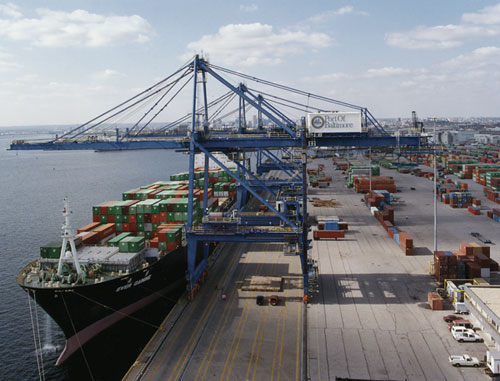
Brian Hayes
For example, just a year after the Munich and Prague arrests, Chechen rebels reportedly buried a small amount of radioactive cesium-137 in a Moscow park and then notified members of a Russian television crew, who subsequently located it. Clearly the goal was to plant fear rather than to inflict physical damage. Had the latter been the rebels' intent (and had they garnered a larger amount of cesium-137), the result might have resembled what went on in Goiania, Brazil, in 1987, when a container of cesium-137 scavenged from a defunct medical clinic was opened and the dangerous contents unwittingly scattered around the community. Children, for example, played with the glowing powder. In the end, four people died, 28 suffered radiation burns, and more than 100,000 requested monitoring. The price tag for the ensuing clean-up effort amounted to some $20 million.
It is thus not surprising, particularly after the attacks of September 11, 2001, that U.S. authorities have become deeply concerned about the possibility of radiological terrorism in this country. Although a dirty bomb would cause few fatalities (if any) and do far less physical damage than crashing a fuel-laden airliner into a crowded building, the psychological toll and cost of decontamination could end up being enormous. And were terrorists able to detonate a stolen or improvised nuclear weapon in an American city, the consequences would, of course, be catastrophic—indeed, they would be world-changing.
Protection against such a ghastly event is a complicated task. In an earlier era, our nation was able to deter aggression by another nuclear-weapon state using its capacity to retaliate with its own atomic arsenal. But that strategy is of little value when the threat comes from international terrorists. And since the collapse of the Soviet Union in the early 1990s, the possibility that such groups might obtain a nuclear weapon, or the materials to construct one, has become quite unnerving. It now creates in the minds of most Americans as much fear as the earlier worries about Soviet nuclear missiles.
The U.S. government has, of course, been laboring to ensure that terrorists never acquire a nuclear bomb. For example, since the early 1990s, the United States has worked with the Russian government to help it secure at the source the vast quantities of nuclear materials amassed during the Cold War under the Soviet regime—some 30,000 weapons and 600 tons of weapons-grade uranium and plutonium. Considerable progress has been made, but this effort is by no means complete. Locking down nuclear materials in the former Soviet Union, the first line of defense, has proved enormously difficult.
One problem is that these dangerous items are so widely distributed. Another is that some of their impoverished custodians may have been all too susceptible to the lure of making quick cash by selling nuclear materials on the black market. And although the Soviet authorities maintained good control over their nuclear weapons, their records of production and inventory for the materials used in weapons construction and in nuclear power generation are so uncertain that it is often impossible even to know whether anything is missing.
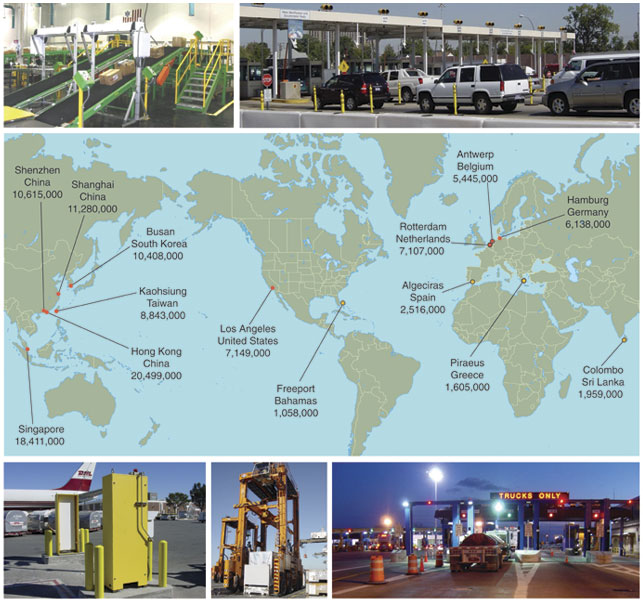
Photographs courtesy of the author; illustration by Russell House; data are from the General Accounting Office report GAO-05-375 and the American Association of Port Authorities 2003 rankings.
Given such difficulties, U.S. authorities have been eager to set up a second line of defense, outfitting border-crossing stations in countries that were formerly within the Soviet Union (and in certain other European and Mediterranean nations) with special equipment so that local customs officials can detect attempts to smuggle nuclear contraband in or out. These efforts include the contributions of several government departments: the Department of Defense, the State Department, the Department of Homeland Security's Customs and Border Protection and the Department of Energy (DOE). The bulk of this work, however, is carried out under the aegis of DOE's National Nuclear Security Administration as part of its Second Line of Defense program, as it is officially called. A large part of that program has been to set up radiation-detection equipment at 39 sites in Russia to prevent the illicit trafficking of nuclear and radiological materials.
Although it is difficult to assess fully the results, it is clear that this effort is having considerable effect. According to the Russian Customs Ministry, last year this monitoring equipment uncovered some 200 attempts to smuggle nuclear or radiological materials. Still, one surmises that considerable opportunity for breaches in security remains. After all, smugglers may be able to shield radioactive material from detection, they might succeed in bribing Russian customs officials to turn the other way, they can route their illicit cargo across unregulated borders in the Russian hinterland, and so forth.
Given that the first and second layers of defense could be rather porous, U.S. authorities have recently begun to put in place an additional layer of protection at the shipping ports that terrorists might try to use to deliver a nuclear weapon or dirty bomb to the United States. In 2003, the Department of Energy began a new part of the Second Line of Defense program called the "Megaports Initiative," which involves outfitting foreign seaports with equipment capable of detecting nuclear materials hidden in shipping containers—those boxy metal units that one often sees stacked high on the deck of cargo ships and being pulled down the highway behind trucks. Although obtaining the necessary international cooperation to set up such installations on foreign soil is no easy task, checking cargo bound for the United States before it reaches its destination is of considerable importance. After all, a terrorist who succeeded in smuggling a nuclear weapon to the United States might well decide to detonate it just as it arrives, before customs officials have a chance to mount an inspection of the shipping container housing it. So far Rotterdam, The Netherlands, and Piraeus, Greece, have had such equipment installed, and four other foreign ports (Colombo, Sri Lanka; Algeciras, Spain; Antwerp, Belgium; and Freeport, Bahamas) are slated to receive similar gear shortly. About a dozen others should follow suit over the next five years.
Government authorities are also setting up an additional tier of defense at various ports of entry here in the United States. One measure taken in this regard has been to harness the x-ray scanners that have been installed over the past decade or so at certain U.S. seaports and border crossings as part of a strategy to find people and contraband hidden in trucks and shipping containers without having to resort to time-consuming physical inspections. Such scanners prove quite useful in probing for shielded radiological weapons. In addition, at many of these entry points customs officials are installing special portals that are capable of detecting telltale radiation. This program has been going on for some time, and just this past April the port of Oakland, California, became the first in the nation to have all the shipping containers arriving from overseas pass through such devices.
What exactly does this new equipment measure? What radioactive substances can be detected in this way? Could any dangerous packages be missed? My colleagues and I at Pacific Northwest National Laboratory have been grappling with the technical issues involved in these efforts for the past three years, and although many of the details are too sensitive to publish, I can broadly outline the state of the art of screening cargo for nuclear materials.
Of the many possibilities that one can imagine, the illicit importation of a fully functional nuclear weapon poses the greatest danger. Although details about the powerful thermonuclear weapons now found on U.S. ballistic missiles are closely held secrets, unclassified information indicates that these devices weigh as little as 68 kilograms. Those of other advanced nuclear powers may be of similar size. So a highly destructive explosive of this type, once stolen, could be easily moved about in an ordinary shipping container. A tactical nuclear weapon could be even easier to transport. An improvised nuclear weapon, one assembled from scratch by a team of determined terrorists, would probably be as large as the uranium bomb that the United States dropped on Hiroshima in 1945—that is, about the size of a small car. And, if built along similar lines, it might be capable of just as much destruction.
Something like 25 kilograms of highly enriched uranium or 4 kilograms of plutonium-239 are sufficient for a nuclear explosive. Unsophisticated designs might employ much more nuclear material. The substances that could be used for a dirty bomb are harder to characterize. Presumably the isotope (or isotopes) employed would be radioactive enough to pose a danger to health but not so radioactive as to decay to a stable form very quickly. Such considerations suggest the possible use of americium-241, californium-252, cesium-137, cobalt-60, iridium-192 or strontium-90.
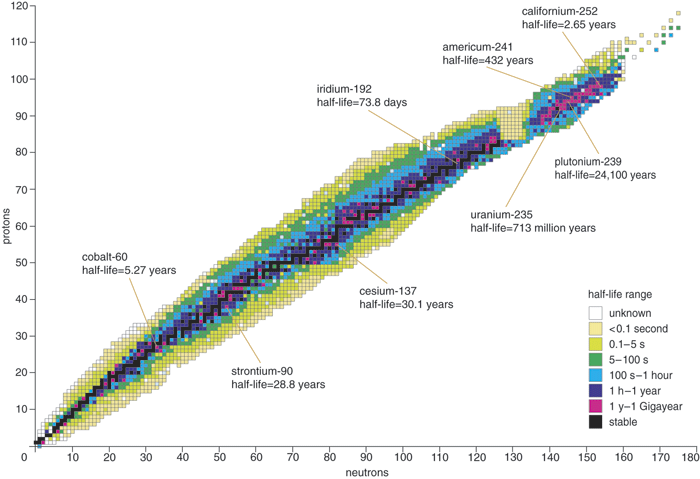
Illustration by Stephanie Freese; adapted from Lawrence Berkeley National Laboratory’s Experimental Chart of the Nuclides 2000.
Most of these radioactive isotopes have been harnessed for one commercial application or another. People working in the oil industry, for example, use californium-252 in equipment for probing the composition of the rock surrounding a borehole. And americium-241 is a key component of most household smoke detectors. Although regulations exist to safeguard the production and use of these substances, it is not difficult to imagine terrorists obtaining significant quantities, perhaps on the black market.
One possible source for dirty-bomb material might be cesium-137 or strontium-90 scavenged from Russian radiothermal generators, devices used to produce electricity at remote locations. Many of these generators have been abandoned in the wilds of what was formerly Soviet territory where they are literally up for grabs. For example, in December 2001 three woodsmen in the former Soviet republic of Georgia suffered radiation burns after handling the strontium-90 core from an abandoned radiothermal generator, presumably one that had been used to power communications equipment.
The highly radioactive nature of such materials makes them inviting components for a terrorist's dirty bomb. But the radiation emitted also makes them relatively easy to detect. The necessary equipment is commercially available and relatively inexpensive.
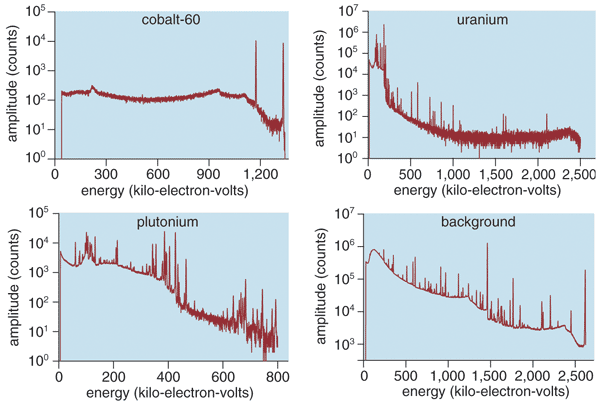
Stephanie Freese
Most radiation monitors work by sensing the gamma rays (that is to say, very energetic photons) that radioactive materials typically emit. Such gamma rays have a characteristic spectrum of energies. When these piercing rays pass through matter, they deposit some of their energy and, in doing so, produce electrons that can be sensed, often by virtue of the visible-light photons they produce in a detector, a process called scintillation.
But gamma rays do not usually give up all of their energy in a single interaction with matter—that process usually takes several scattering events. And the plastic scintillators used in many radiation detectors have too low a density to ensure that all of the gamma-ray energy will be absorbed in this way. These instruments thus cannot measure the amount of energy in the originating gamma ray, making it difficult to identify the radioactive material. More sophisticated, and expensive, designs employ pure crystal scintillators or solid-state devices, which are of higher density and allow (at least in some cases) for the full energy of the gamma ray to be deposited inside the detector. This property in turn permits such equipment to register the full energy spectrum, which makes identification of the radioactive isotope straightforward.
Some radioactive materials, in particular strontium-90, do not directly produce gamma rays and instead give off beta radiation—that is, energetic electrons. Beta rays are readily shielded, but when they slow down in matter, these energetic electrons produce bremsstrahlung radiation, which is a continuum of gamma rays. These rays can then be detected in the same manner as those from nuclear emissions, but the resulting spectrum is not unique to the source.
The materials found inside a nuclear weapon—highly enriched uranium or weapons-grade plutonium—are much less radioactive than the various isotopes that might go into a dirty bomb, making these "special nuclear materials" harder to detect. Plutonium (like californium-252) also emits neutrons, which are rather rare in most environments. The low natural background (which comes mostly from cosmic rays) potentially makes the detection of neutrons a highly sensitive test for these dangerous substances.
Neutron counters work either by sensing the protons that fly off when neutrons strike and dislodge hydrogen nuclei in the appropriate detector material or by registering the gamma rays, electrons or other charged particles given off after the neutron is absorbed by a suitable nucleus—helium-3 or lithium-6, for example. Neutrons are more likely to undergo such interactions if they are moving at about the same speed as the material around them, a condition that physicists refer to as being "thermalized." The fission neutrons that plutonium gives off move much faster. So detectors are usually surrounded by several centimeters of hydrogen-rich material, which slows a fast neutron after it makes several collisions. Hydrogen is used because it weighs about the same as a neutron. The process is akin to slowing a speedy billiard ball by letting it collide a few times with other (slowly moving) billiard balls. Using larger atoms would be far less effective—as would trying to slow a billiard ball by bouncing it off so many bowling balls.
Uranium, even if highly enriched in the fissile isotope uranium-235, does not give off many neutrons. Rather, it emits alpha particles (an alpha particle is equivalent to the nucleus of a helium atom) and gamma rays. But with a half-life of about a billion years—longer for the common, nonfissile isotope, uranium-238—it is not particularly radioactive, making its detection a formidable challenge.
Another significant problem is the distinct possibility, indeed the probability, that smugglers would place radiation shielding, perhaps a shell of lead, around any nuclear materials they were trying to move. They could also try to foil detection efforts by placing the illicit cargo within a screen of innocuous material that itself was slightly radioactive—fertilizer, kitty litter, granite slabs, road salt, abrasives, television sets and glazed ceramics are on the list of suitable "interference cargo," as are the many man-made sources of radiation found in various items of legal commerce, including smoke detectors and medical isotopes.
The presence of such materials elevates the background radiation level and frequently proves an annoyance, setting off alerts unnecessarily. (Kitty litter and the medical isotopes account for about half of all nuisance alarms at some radiation-monitoring locations.) A greater concern is that interference cargo possibly could be employed to limit the ability of portal monitors to identify dangerous sources of radiation. For this reason, authorities are working hard to implement additional detection techniques.
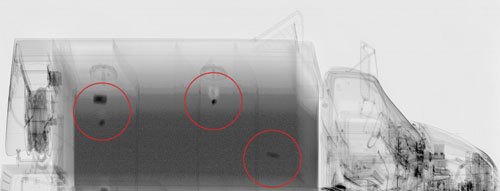
Image courtesy of American Science and Engineering
One technological solution for the problem of radiation shielding is already widely employed: x-ray imaging. A smuggler would have a hard time placing illicit cargo in a massive lead enclosure without it showing up on an x-ray scan. Active interrogation with gamma rays is also possible. The advantage is that suitably energetic gamma rays induce fission in uranium and plutonium, giving rise to additional gamma rays or neutrons, which in turn can be detected.
Such gamma-ray imaging systems have been demonstrated in the laboratory and are now undergoing commercial development and testing. Another possible method of "active detection" uses neutrons as a probe. Like gamma rays, neutrons can also induce fission in uranium and plutonium. So by sensing the gamma rays or neutrons that are given off in response, one can test for the presence of these and other dangerous nuclear materials.
What happens when a shipping container passing through a radiation portal triggers an alarm? Customs officials would then examine the contents of the container more closely using portable radiation detectors. At their simplest, the equipment might take the form of "radiation pagers," small units that can fit in a pocket or be worn on a belt. Such devices are useful for surveying cargo that would be awkward to access with bulkier equipment, and they help to protect inspectors from extremely radioactive sources of gamma rays. The people carrying out the inspection of a suspicious shipping container might thus all carry radiation pagers, but they would most likely also examine the cargo with larger handheld detectors that are able to identify different gamma-ray emitters, so-called radioisotope-identifier devices.
Although there remains plenty of room for technological improvement in such instrumentation, the success of U.S. interdiction efforts will hinge on other factors as well. Effective intelligence operations will be able to warn customs authorities about certain vessels or cargo in need of careful scrutiny. And experienced border officers will always be able to evaluate the attitude and behavior of those passing their checkpoints. Combined with suitable technical aids, these traditional tools become that much more powerful.
Might a determined group of terrorists still elude detection and transport dangerous nuclear materials into the United States? Very possibly. How? A large number of scenarios have been considered; which is the most likely? The best answer I can give is that it will be something we are not expecting. Screening cargo at our borders provides a deterrent, but it is by no means foolproof. A terrorist, like a drug smuggler, might succeed in sidestepping the barriers being put in place by exploiting the ample space that exists between legal points of entry.
U.S. borders were never intended to be sealed, and the nation's ports were designed to speed commerce, not to provide security. In addition, the people staffing them are often overwhelmed. What's more, there is very little stopping terrorists from gathering up materials for a dirty bomb within the United States. So ultimately, the technical solutions my colleagues and I are working to provide cannot offer complete security. Perhaps all we are doing is delaying the inevitable, but we are delaying it. If we are successful in doing so for long enough that terrorism becomes less widely practiced, these efforts will have been of great benefit to the nation.
Click "American Scientist" to access home page
American Scientist Comments and Discussion
To discuss our articles or comment on them, please share them and tag American Scientist on social media platforms. Here are links to our profiles on Twitter, Facebook, and LinkedIn.
If we re-share your post, we will moderate comments/discussion following our comments policy.